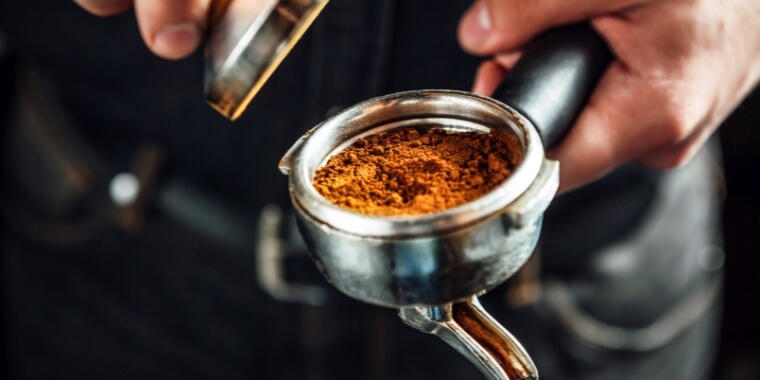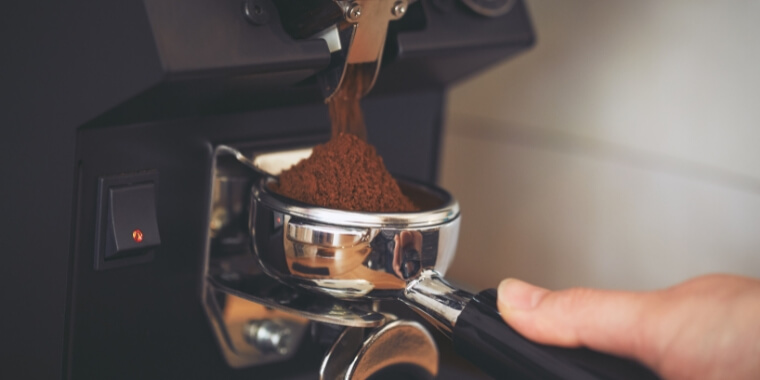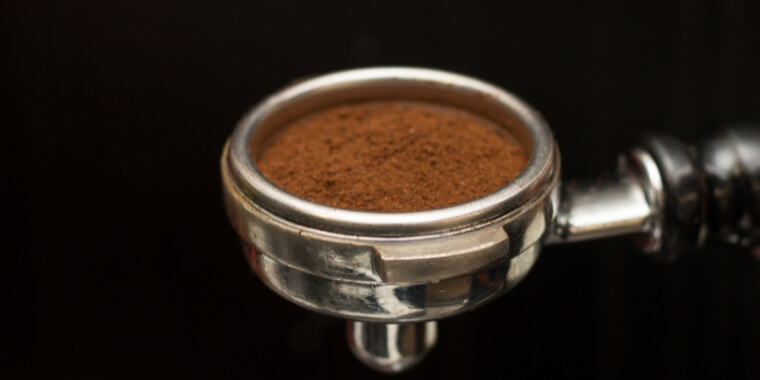Creating the perfect shot of espresso isn’t as easy as it seems. One issue I came across early on was something called “espresso channeling.”
If you’re just starting your espresso adventure, it’s essential to understand what channeling is, why it’s a problem, and how to prevent it.
So, What Is Espresso Channeling?
In simple terms, channeling is when water finds the path of least resistance through the coffee grounds in the portafilter.
Instead of evenly extracting flavors from all the grounds, water flows through specific areas, causing an uneven extraction. This can lead to your espresso tasting sour, bitter, or just plain off.
When I realized that channeling was affecting my espresso, I knew I had to learn more about it.
In the following sections, I’ll share my experiences and tips on identifying and preventing espresso channeling, so you too can enjoy a perfect shot of espresso every time.
What Causes Espresso Channeling?

There are several factors that contribute to channeling. By understanding these causes, you can take steps to prevent them and consistently create delicious espresso.
Let’s explore the main reasons behind espresso channeling:
Uneven coffee grounds distribution
One of the first things I realized when dealing with channeling was the importance of even coffee grounds distribution.
If the grounds aren’t level in the portafilter, water will naturally flow through the lower areas, causing channeling.
Two common culprits for uneven distribution are tamping inconsistencies and grinder issues.
When I first started making espresso, my tamping technique was far from perfect. I learned that applying even pressure while tamping is crucial to prevent channeling. Practicing my tamping skills and using a leveler helped me get consistent results.
Another factor to consider is your grinder. A quality grinder that produces uniform coffee grounds can significantly reduce the risk of channeling. When I upgraded my grinder, I noticed a substantial improvement in the consistency of my shots.
Poor coffee puck preparation
Proper coffee puck preparation is essential for preventing channeling. Two key aspects of puck preparation are the right amount of coffee grounds and their freshness.
Overfilling or underfilling the portafilter can cause channeling. By using a scale and adjusting the dose according to the size of the portafilter basket, I will achieve better consistency in my extractions.
Coffee ground freshness is another factor that can impact channeling. When I started using freshly roasted and ground beans, I noticed a considerable improvement in the taste and evenness of my espresso shots.
Equipment-related factors
The condition of your equipment plays a role in channeling as well. Worn or damaged portafilter baskets and uneven or insufficient pressure from the espresso machine can cause issues.
If you are in a hurry, here’s a brief summary
The main causes of channeling when making espresso include uneven coffee ground distribution, poor coffee puck preparation, and equipment-related factors.
How to Avoid Channeling In Espresso?

If you are wondering how to stop espresso channeling there’s no simple answer. However, through trial and error, I discovered several strategies to help me overcome channeling.
To fix the issue properly you need to learn what causes channeling in espresso. Here are some practical tips to help you prevent and fix espresso channeling in your brewing process.
1. Improving coffee grounds distribution
One of the most effective ways to prevent channeling is by improving your coffee grounds distribution. I found that mastering proper tamping techniques and investing in a quality grinder were crucial steps in this process.
To improve my tamping, I practiced applying even pressure and leveling the coffee grounds in the portafilter. A leveler or distribution tool can also be a game-changer, ensuring a consistent tamp every time.
A quality grinder was another essential investment. By upgrading to a better grinder, I achieved more uniform coffee grounds, which significantly reduced the risk of channeling.
2. Fixing Side Tamping
Another cause of channeling I experienced was side tamping.
When the tamp isn’t applied straight down with even pressure, it can create uneven density in the coffee puck. This, in turn, causes channeling.
Practicing my tamping technique and using a leveler helped me overcome this issue.
3. Grinding Too Fine
I found that grinding my coffee too fine could also lead to channeling. When the coffee grounds are too fine, they can clump together, creating channels for the water to flow through.
Adjusting my grinder to a slightly coarser setting helped me prevent channeling and achieve a more balanced extraction.
4. Perfecting puck preparation
To create the perfect coffee puck, I focused on correctly dosing coffee grounds and ensuring their freshness.
These two factors can greatly impact the quality of your espresso and help prevent channeling.
I learned to dose the right amount of coffee grounds for my portafilter basket using a scale. This helped me avoid overfilling or underfilling, which can contribute to channeling.
I also started using freshly roasted and ground coffee beans. Fresh coffee grounds not only taste better but also help prevent channeling by ensuring even extraction.
5. Low Dose in the Basket
Having a low dose of coffee grounds in the portafilter basket can also cause channeling.
When there’s not enough coffee in the basket, the water can flow too freely, leading to uneven extraction.
By accurately dosing my coffee grounds and adjusting the dose to match my portafilter basket size, I can achieve a more consistent extraction and prevent channeling from happening.
6. Maintaining equipment
Lastly, maintaining your espresso equipment is vital to preventing channeling. I found that regularly checking and replacing portafilter baskets and calibrating and servicing my espresso machine made a significant difference.
I could maintain optimal extractions and prevent channeling by inspecting my portafilter basket for wear and damage. Additionally, keeping my espresso machine in good working order ensured consistent pressure and even extraction.
If you are in a hurry, here’s a brief summary
Practical tips to prevent and fix channeling in espresso include improving coffee grounds distribution, fixing side tamping, adjusting grind size, perfecting puck preparation, ensuring accurate dosing, and maintaining equipment.
Spot The Signs (How to Identify Espresso Channeling)

Recognizing the signs of coffee channeling is essential to improving your brewing skills.
Here, I’ll share some common indicators of channeling that I encountered, making it easier for you to spot and address this issue in your espresso-making process.
The espresso shot starts relatively quickly
One sign of channeling I noticed was that the espresso shot started relatively quickly, sometimes almost immediately after engaging the pump.
This was accompanied by a thin, dark watery fluid pouring from the portafilter spouts, with stripes of blonde and spots of darker colors.
This uneven flow is a clear indication that channeling was occurring.
Taste evaluation
Of course, the ultimate test for channeling is in the taste.
To identify channeling through taste evaluation, you’ll need to compare the flavor profiles of well-extracted and channeled espresso.
At first, it was challenging for me to recognize the differences. But with practice, I learned to discern the subtle variations in taste that indicated channeling.
For example, if my espresso tasted too sour or too bitter, I knew that I had to make adjustments to prevent channeling.
A lack of crema, or pale crema
Another sign of channeling that I encountered was a lack of crema or a pale, thin crema on top of the espresso shot.
A rich, golden-brown crema is a sign of a well-extracted espresso, so when I observed a pale or thin crema, I knew that channeling was affecting the quality of my brew.
Weak flavor
When channeling occurred, I often found that my espresso shots had a weak flavor, lacking the full-bodied richness that I desired.
This weak taste was a sign that the water was not extracting the coffee grounds evenly, resulting in an unbalanced and underwhelming espresso.
More Espresso Than You Expect
Another indicator of channeling that I noticed was a larger brewed volume than expected. When channeling happens, the water can flow too quickly through the coffee puck, producing more fluid in the espresso shot than intended. This excess volume can dilute the flavor and affect the overall quality of the espresso.
Pinholes in Your Puck
Finally, I discovered that inspecting the used coffee puck could provide valuable insights into channeling. When I spotted one or many small pinholes in the puck, it indicated that water had found a path of least resistance and created channels through the coffee grounds, resulting in an uneven extraction.
Bonus: Cheatsheet on Espresso Channeling Causes and Fixes
| Causes of Espresso Channeling | How to Fix It |
| Poor Coffee Grounds Distribution | Distribute grounds evenly and level before tamping |
| Side Tamping | Practice even pressure tamping and use a leveler |
| Grinding Too Fine | Adjust the grinder to a slightly coarser setting |
| Uneven Grounds Saturation | Ensure consistent pressure and even water distribution |
| Low Dose in the Basket | Accurately dose coffee grounds for the basket size |
| Tamping Inconsistencies | Develop a consistent tamping technique |
| Grinder Issues | Invest in a quality grinder for uniform grounds |
| Overfilling/Underfilling Portafilter | Use a scale to dose the right amount of coffee grounds |
| Coffee Ground Freshness | Use freshly roasted and ground coffee beans |
| Worn/Damaged Portafilter Baskets | Check and replace baskets regularly |
| Uneven/Insufficient Espresso Machine Pressure | Calibrate and service the espresso machine regularly |
Some Questions You May Have
Why is my espresso channeling when using light roast?
Your espresso may be channeling when using a light roast because light roasts are typically denser and harder than darker roasts, which can make it more difficult to achieve an even extraction.
To address this issue, you might need to adjust your grinder to a slightly finer setting, distribute the grounds more evenly in the portafilter, and apply consistent tamping pressure to ensure proper extraction.
Why is my espresso channeling always in the same spot?
If your espresso is channeling always in the same spot, it could be due to an uneven distribution of coffee grounds or an issue with your tamping technique.
To fix this, make sure you distribute the grounds evenly in the portafilter and practice applying even pressure when tamping.
Additionally, check your portafilter basket for any damage or wear that could contribute to the recurring channeling issue.
Why is my espresso channeling always in the middle?
Espresso channeling in the middle of the coffee puck might be caused by uneven tamping or an uneven distribution of coffee grounds.
To prevent channeling in the middle, ensure you distribute the grounds evenly, focusing on leveling the surface before tamping.
Also, practice applying even pressure during tamping, which will help create a uniform density throughout the coffee puck and prevent channeling.
Why is bottomless portafilter channeling?
Channeling in your bottomless portafilter could be a result of puck preparation problems.
To tackle this, think about using a fine needle to mix the coffee grounds prior to tamping, which can assist in achieving a more uniform distribution.
Furthermore, verify that the coffee grounds are level, both before and after tamping, to establish a consistent density within the coffee puck.
Another technique to consider is pre-infusing the coffee, allowing the puck to expand and form a side seal while filling any tiny gaps that might lead to channeling.
My Final Thoughts
Channeling may seem like a daunting obstacle at first, but with practice and persistence, it can be overcome.
Remember that addressing channeling is a crucial step toward becoming a skilled barista.
Keep refining your techniques and learning from your experiences, and soon, you’ll be brewing exceptional espresso that delights your taste buds and impresses your friends.


